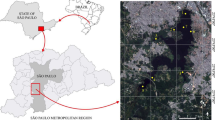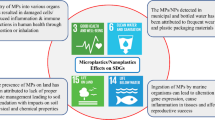Abstract
Lake sediments are important reservoirs for polycyclic aromatic hydrocarbons (PAHs) in catchments. Knowledge of occurrence, sources, and toxicological risk of PAHs is crucial to abate their pollution and risk. We investigated the spatial and temporal occurrence, sources, and potential toxicological risks of 12 PAHs in the surface sediments and one sediment core of the largest deep lake (Lake Fuxian) of China. Our results indicated the average ΣPAH12 in the surface sediments of this lake was 1550.6 ± 231.4 ng g −1dw , much higher than those of most Chinese shallow lakes. The average ΣPAH12 in the lake area was higher than that in the estuaries. The average ΣPAH12 in the estuaries of influent rivers was higher than that of the outlet river. Coal combustion, gasoline combustion, and diesel combustion were the major sources, which contributed 68.5%, 19.8%, and 11.8% to the ΣPAH12. The average total benzo[a]pyrene toxic equivalent concentration (TEQcarc) of the six most carcinogenic PAHs was 317.1 ± 86.3 ngTEQcarc g−1 in the surface sediments. The ΣPAH12 increased from 301.7 to 1964.4 ng g −1dw from 1945 to 2011 and significantly increased with the GDP and population of the catchment. The contribution of coal combustion to the concentrations of PAHs increased gradually with time. The total TEQcarc, and the percentage of ΣPAHcarc to ΣPAH12 in the sediment core increased from 5.0 to 84.6 ngTEQcarc g−1 and from 5.7 to 23.3%, respectively. Our study highlights the importance of such deep waters in burying PAHs and the increasing risk of PAHs from human activities.











Similar content being viewed by others
References
Antonopoulos VZ, Gianniou SK (2003) Simulation of water temperature and dissolved oxygen distribution in Lake Vegoritis, Greece. Ecol Model 160:39–53. https://doi.org/10.1016/S0304-3800(02)00286-7
Appleby P (2002) Chronostratigraphic techniques in recent sediments. In: Tracking environmental change using lake sediments. Springer, pp 171–203
Bzdusek PA, Christensen ER, Li A, Zou Q (2004) Source apportionment of sediment PAHs in Lake Calumet, Chicago: application of factor analysis with nonnegative constraints. Environ Sci Technol 38:97–103. https://doi.org/10.1021/es034842k
Dai X, Zhou Y, Ma W, Zhou L (2017) Influence of spatial variation in land-use patterns and topography on water quality of the rivers inflowing to Fuxian Lake, a large deep lake in the plateau of southwestern China. Ecol Eng 99:417–428. https://doi.org/10.1016/j.ecoleng.2016.11.011
Deng W, Li XG, Li SY, Ma YY, Zhang DH (2013) Source apportionment of polycyclic aromatic hydrocarbons in surface sediment of mud areas in the East China Sea using diagnostic ratios and factor analysis. Mar Pollut Bull 70:266–273. https://doi.org/10.1016/j.marpolbul.2013.02.032
Downing JA et al (2006) The global abundance and size distribution of lakes, ponds, and impoundments. Limnol Oceanogr 51:2388–2397
Elmquist M, Zencak Z, Gustafsson Ö (2007) A 700 year sediment record of black carbon and polycyclic aromatic hydrocarbons near the EMEP air monitoring station in Aspvreten, Sweden. Environ Sci Technol 41:6926–6932. https://doi.org/10.1021/es070546m
EPA U (1993) Provisional guidance for quantitative risk assessment of polycyclic aromatic hydrocarbons. Development 1–28
Gevao B, Jones KC, Hamilton-Taylor J (1998) Polycyclic aromatic hydrocarbon (PAH) deposition to and processing in a small rural lake, Cumbria UK. Sci Total Environ 215:231–242. https://doi.org/10.1016/S0048-9697(98)00129-6
Gu Y-G, Li H-B, Lu H-B (2017) Polycyclic aromatic hydrocarbons (PAHs) in surface sediments from the largest deep plateau lake in China: occurrence, sources and biological risk. Ecol Eng 101:179–184. https://doi.org/10.1016/j.ecoleng.2017.02.007
Guo W, Pei Y, Yang Z, Chen H (2011) Historical changes in polycyclic aromatic hydrocarbons (PAHs) input in Lake Baiyangdian related to regional socio-economic development. J Hazard Mater 187:441–449. https://doi.org/10.1016/j.jhazmat.2011.01.052
Harrison RM, Smith DJT, Luhana L (1996) Source apportionment of atmospheric polycyclic aromatic hydrocarbons collected from an urban location in Birmingham, U.K. Environ Sci Technol 30:825–832. https://doi.org/10.1021/es950252d
Hu G et al (2010) Organochlorine compounds and polycyclic aromatic hydrocarbons in surface sediment from Baiyangdian Lake, North China: concentrations, sources profiles and potential risk. J Environ Sci 22:176–183. https://doi.org/10.1016/S1001-0742(09)60090-5
Kannan K, Johnson-Restrepo B, Yohn SS, Giesy JP, Long DT (2005) Spatial and temporal distribution of polycyclic aromatic hydrocarbons in sediments from Michigan inland lakes. Environ Sci Technol 39:4700–4706
Larsen RK, Baker JE (2003) Source apportionment of polycyclic aromatic hydrocarbons in the urban atmosphere: a comparison of three methods. Environ Sci Technol 37:1873–1881. https://doi.org/10.1021/es0206184
Li et al (2015) Sources and ecological risk assessment of PAHs in surface sediments from Bohai Sea and northern part of the Yellow Sea, China. Mar Pollut Bull 96:485–490. https://doi.org/10.1016/j.marpolbul.2015.05.002
Li S, Tao Y, Yao S, Xue B (2016) Distribution, sources, and risks of polycyclic aromatic hydrocarbons in the surface sediments from 28 lakes in the middle and lower reaches of the Yangtze River region, China. Environ Sci Pollut Res 23:4812–4825. https://doi.org/10.1007/s11356-015-5705-y
Li et al (2017) National investigation of semi-volatile organic compounds (PAHs, OCPs, and PCBs) in lake sediments of China: occurrence, spatial variation and risk assessment. Sci Total Environ 579:325–336. https://doi.org/10.1016/j.scitotenv.2016.11.097
Liu G, Zhang G, Jin Z, Li J (2009) Sedimentary record of hydrophobic organic compounds in relation to regional economic development: a study of Taihu Lake, East China. Environ Pollut 157:2994–3000
Liu W, Wu J, Zeng H, Ma L (2014) Geochemical evidence of human impacts on deep Lake Fuxian, southwest China. Limnologica 45:1–6. https://doi.org/10.1016/j.limno.2013.09.003
May WE, Wise SA (1984) Liquid chromatographic determination of polycyclic aromatic hydrocarbons in air particulate extracts. Anal Chem 56:225–232. https://doi.org/10.1021/ac00266a024
Nadal M, Schuhmacher M, Domingo JL (2004) Levels of PAHs in soil and vegetation samples from Tarragona County, Spain. Environ Pollut 132:1–11. https://doi.org/10.1016/j.envpol.2004.04.003
Nisbet ICT, LaGoy PK (1992) Toxic equivalency factors (TEFs) for polycyclic aromatic hydrocarbons (PAHs). Regul Toxicol Pharm 16:290–300. https://doi.org/10.1016/0273-2300(92)90009-X
Peters CA, Knightes CD, Brown DG (1999) Long-term composition dynamics of PAH-containing NAPLs and implications for risk assessment. Environ Sci Technol 33:4499–4507. https://doi.org/10.1021/es981203e
Qin B (2004) Dynamics of sediment resuspension and the conceptual schema of nutrient release in the large shallow Lake Taihu. China Chin Sci Bull 49:54–58. https://doi.org/10.1360/03wd0174
Savinov VM, Savinova TN, Matishov GG, Dahle S, Næs K (2003) Polycyclic aromatic hydrocarbons (PAHs) and organochlorines (OCs) in bottom sediments of the Guba Pechenga, Barents Sea, Russia. Sci Total Environ 306:39–56. https://doi.org/10.1016/S0048-9697(02)00483-7
Shen H et al (2013) Global atmospheric emissions of polycyclic aromatic hydrocarbons from 1960 to 2008 and future predictions. Environ Sci Technol 47:6415–6424
Simcik MF, Eisenreich SJ, Lioy PJ (1999) Source apportionment and source/sink relationships of PAHs in the coastal atmosphere of Chicago and Lake Michigan. Atmos Environ 33:5071–5079. https://doi.org/10.1016/S1352-2310(99)00233-2
Smirnov A, Abrajano TA, Smirnov A, Stark (1998) Distribution and sources of polycyclic aromatic hydrocarbons in the sediments of Lake Erie, Part 1. Spatial distribution, transport, and deposition. Org Geochem 29:1813–1828
Tao Y, Yao S, Xue B, Deng J, Wang X, Feng M, Hu W (2010) Polycyclic aromatic hydrocarbons in surface sediments from drinking water sources of Taihu Lake, China: sources, partitioning and toxicological risk. J Environ Monit 12:2282–2289
Tao S et al (2018a) Quantifying the rural residential energy transition in China from 1992 to 2012 through a representative national survey. Nat Energy 3:567–573. https://doi.org/10.1038/s41560-018-0158-4
Tao Y, Yu J, Liu X, Xue B, Wang S (2018b) Factors affecting annual occurrence, bioaccumulation, and biomagnification of polycyclic aromatic hydrocarbons in plankton food webs of subtropical eutrophic lakes. Water Res 132:1–11. https://doi.org/10.1016/j.watres.2017.12.053
Venkataraman C, Lyons JM, Friedlander SK (1994) Size distributions of polycyclic aromatic hydrocarbons and elemental carbon. 1. Sampling, measurement methods, and source characterization. Environ Sci Technol 28:555–562. https://doi.org/10.1021/es00053a005
Wakeham SG, Forrest J, Masiello CA, Gélinas Y, Alexander CR, Leavitt PR (2004) Hydrocarbons in Lake Washington sediments. A 25-year retrospective in an urban lake. Environ Sci Technol 38:431–439. https://doi.org/10.1021/es0343149
Weiss RF, Carmack Carmack EC, Koropalov VM (1991) Deep-water renewal and biological production in Lake Baikal. Nature 349:665–669. https://doi.org/10.1038/349665a0
Xu J, Guo J-Y, Liu G-R, Shi G-L, Guo C-S, Zhang Y, Feng Y-C (2014) Historical trends of concentrations, source contributions and toxicities for PAHs in dated sediment cores from five lakes in western China. Sci Total Environ 470–471:519–526. https://doi.org/10.1016/j.scitotenv.2013.10.022
Yang G, Ma R, Zhang L, Jiang J, Yao S, Zhang M, Zeng H (2010) Lake status, major problems and protection strategy in China. J Lake Sci 22:799–810
Yao S, Xue B, Tao Y (2013) Sedimentary lead pollution history: lead isotope ratios and conservative elements at East Taihu Lake, Yangtze Delta, China. Quat Int 304:5–12. https://doi.org/10.1016/j.quaint.2012.10.058
Yunker MB, Macdonald RW, Vingarzan R, Mitchell RH, Goyette D, Sylvestre S (2002) PAHs in the Fraser River basin: a critical appraisal of PAH ratios as indicators of PAH source and composition. Org Geochem 33:489–515
Zhao Z, Zhang L, Wu J (2016) Polycyclic aromatic hydrocarbons (PAHs) and organochlorine pesticides (OCPs) in sediments from lakes along the middle-lower reaches of the Yangtze River and the Huaihe River of China. Limnol Oceanogr 61:47–60. https://doi.org/10.1002/lno.10197
Zhou Q, Zhang Y, Li K, Huang L, Yang F, Zhou Y, Chang J (2018) Seasonal and spatial distributions of euphotic zone and long-term variations in water transparency in a clear oligotrophic Lake Fuxian, China. J Environ Sci 72:185–197. https://doi.org/10.1016/j.jes.2018.01.005
Acknowledgements
This work was funded by Natural Science Foundation of Jiangsu Province (BK20170049), Natural Science Foundation of China (41471400), Youth Innovation Promotion Association CAS, National Basic Technological Research of China (2015FY110900 and 2014FY110400), and Foundation of Nanjing Institute of Geography and Limnology, Chinese Academy of Sciences (NIGLAS2016TD01).
Author information
Authors and Affiliations
Corresponding author
Rights and permissions
About this article
Cite this article
Tao, Y., Xue, B. & Feng, M. Spatial and Historical Occurrence, Sources, and Potential Toxicological Risk of Polycyclic Aromatic Hydrocarbons in Sediments of the Largest Chinese Deep Lake. Arch Environ Contam Toxicol 77, 501–513 (2019). https://doi.org/10.1007/s00244-019-00650-9
Received:
Accepted:
Published:
Issue Date:
DOI: https://doi.org/10.1007/s00244-019-00650-9




